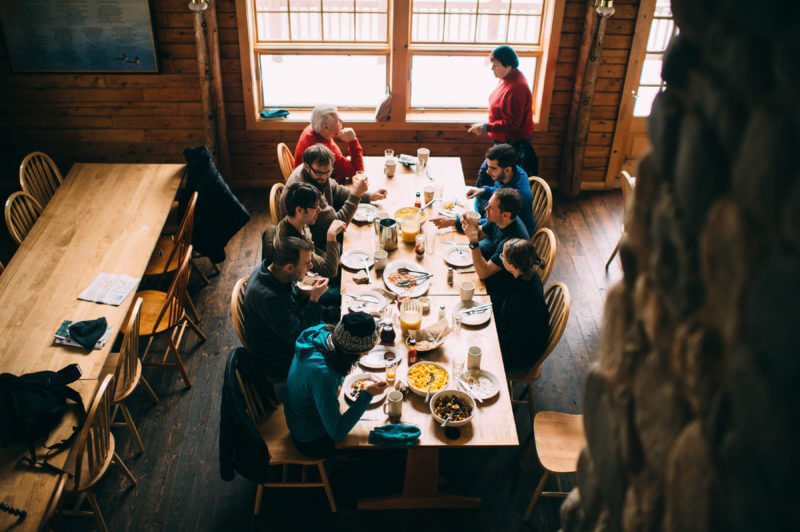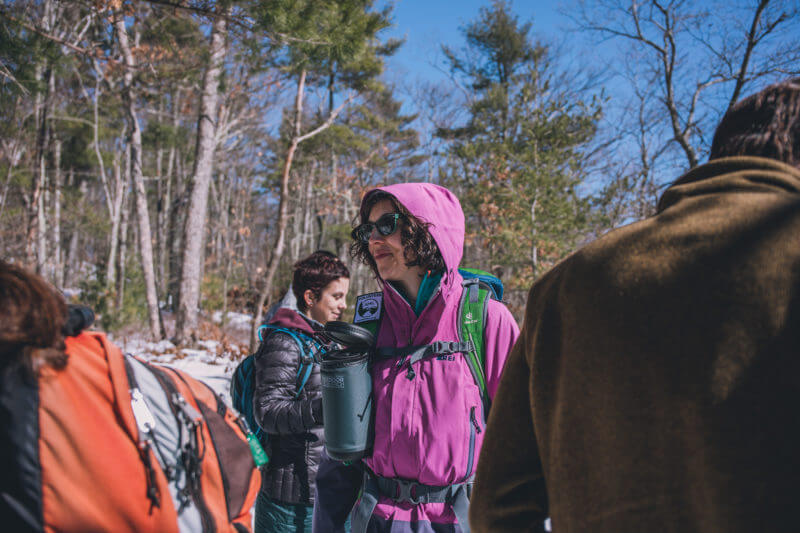

Feb. 2, 2017. AMC Little Lyford Lodge and Cabins, Maine Woods, Maine– Photo by Alexandra Kosiba.
When venturing out on a hike in the colder months, staying warm and safe with traction and proper layers are key differences from summertime adventures, but don’t underestimate the importance of eating the right foods and staying hydrated to keep your body warm and fueled. To help cut through the fads and bad advice, though, we’ve put together a simple guide to the basics of nutrition for a winter hike.
Cold Burn
The first thing to keep in mind is how many more calories we burn when the digits drop. On any hike or physically demanding outing, we use energy that requires calories to keep our bodies moving. When we exert ourselves outdoors in frigid temperatures, we not only have to take in enough calories to fuel energy burned, we also must account for the fact that our bodies need even more calories than we might realize to stay warm—a fact demonstrated in a 2017 National Outdoor Leadership School (NOLS) study. Participants in the NOLS study went on two hikes over the same route—one in the winter and one in spring—burning 34 percent more calories, or an average of 1,000 more calories, on their winter hike than in the spring. While not all hikers carefully count every calorie, seasoned winter hikers often recommend bringing twice the food you would bring on a similar hike in the summer. Packing extra food isn’t just about comfort and full bellies on the trail; because these calories are essential in keeping you warm and moving, not having enough food on your winter hike can lead to dangerous situations, including hypothermia. Always bring more than what you think you’ll need.
What to Eat
As far as what kind of foods and energy types to consume on the trail in winter, nutritionists recommend packing a blend of carbohydrates, fats, and proteins. Our bodies use all of these together to create efficient energy to keep us going. Carbs, for example, give us a nice quick burst of energy, but can cause a “crash” and fatigue shortly after. Fats and proteins are slower burning and have more effect on our long-term energy levels. Having snacks on the trail that incorporate all the different energy types allow us to avoid fatigue and help us feel more stable on the hike. As with most things in winter, managing the cold is paramount, and if we are hungry with low energy levels, we can find ourselves in dangerous situations. My staple trail snacks include a variety of nuts, chocolates, cheese, meat sticks, energy bars, dehydrated fruits, crackers, and the like. Or you could bake nutritionist Nicole Courmier’s super cookies, perhaps the perfect trail food. I tend to “graze” a bit more on winter outings; I would rather munch on small snacks during several short breaks than get too cold on an extended lunch stop in the snow. Also consider what you are eating before you even set foot on the trail. AMC’s lodges offer hardy full course breakfasts that fuel you up for any excursion.


AMC Worcester Chapter hike leader Alex Molinar takes a sip from a water bottle that’s insulated from freezing.
Winter Hydration
Cold days can trick us into thinking we aren’t thirsty and don’t need water, but water is key to staying warm and full of energy out on the trail. Stopping to drink ice cold water in subfreezing temperatures can feel almost painful, but just like food, water is essential in maintaining our core temperature. Winter air is also surprisingly dry, potentially leading to further dehydration when we aren’t aware. With dehydration comes colder body temperatures, which put us more at risk for hypothermia and other cold injuries. To help keep my water levels up even in the cold, I always carry a thermos with hot water in addition to my regular bottles. I find that I’ll drink more water more frequently if I have a hot thermos to sip on in between drinking from my ice-cold water bottles.
Avoid Frozen Food
Also consider what the cold will do to your food and water and avoid snacks that may freeze. Some of my favorite trail snacks in the summer become nearly impossible to eat once exposed to freezing temperatures—you could chip a tooth on a frozen Snickers or Clif bar! Either avoid snacks with higher water content or store them in the pocket of an inner layer so they can remain thawed next to your body.
Pay particular attention to preventing water from freezing. This can prove challenging, but many winter hikers have tips and tricks to manage this. Avoid narrow-mouth bottles, as the cap can freeze faster than wide mouth bottles. Bring multiple bottles just in case one freezes; I keep one wrapped in a fluffy wool sock and another in a bottle “parka,” which is an insulating sleeve for your bottle that you can attach to your pack. I also carry my bottles upside down in winter; if the water in the bottle begins to freeze, it will do so from the top down (think of a pond freezing). Even if it starts to freeze, you can flip the bottle over and still be able to open the cap and drink the water that hasn’t frozen yet. Consider ditching your hydration bladder in the winter. Even in mildly cold temperatures, the hose and mouthpiece can freeze quickly, rendering it useless. Some brands make an insulated tube that helps stave off the cold, but I’ve still seen insulated tubes freeze in the winter. If you absolutely cannot forgo your favorite hydration bladder, keep the hose zipped up in your jacket and against your warm body and blow the lingering water in the tube back into the bladder after each sip.
Plan Your Winter Fuel
As with everything in winter, proper nutrition requires effort and intention. How you are supporting your body is the first step in a successful outing and can help you avoid life-threatening scenarios and cold injuries. For a more in-depth discussion on winter nutrition and all things winter hiking, consult AMC’s Essential Guide to Winter Recreation and check out AMC’s Real Trail Meals for practical tips and ideas on what food to bring to fuel your next winter adventure.